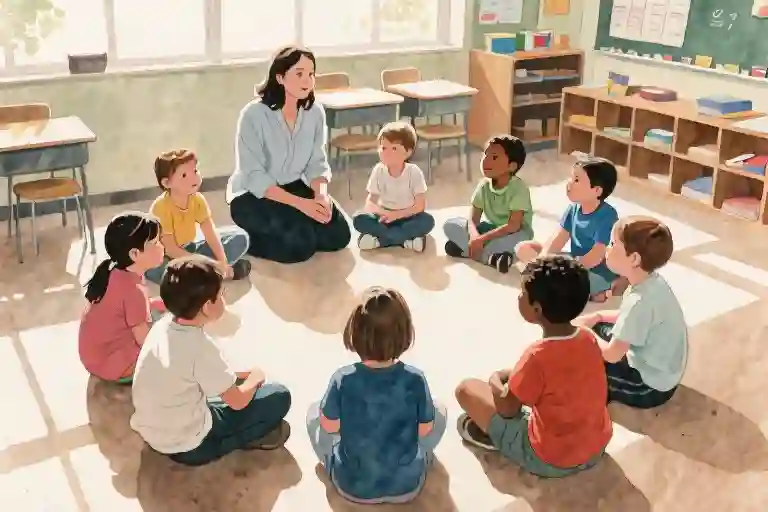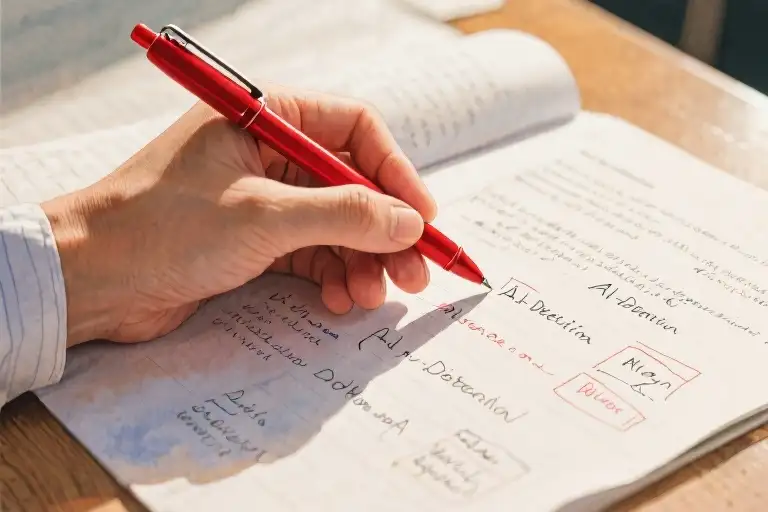The cafeteria noise faded into background static the moment I saw their faces. Third graders shouldn’t look like that – lips pressed tight, shoulders hunched forward, eyes darting away when mine met theirs. ‘You think we’ll never be anything,’ one mumbled, kicking at the linoleum floor with scuffed sneakers. That’s when I realized my careless lunchroom comparison had traveled farther than intended.
As a specials teacher in this Title 1 district, I see these kids briefly but regularly – art class once a week, lunch duty daily. The rhythm of our interactions had felt comfortable until that moment. My stomach dropped remembering how casually I’d remarked to another teacher about classroom behaviors, never imagining small ears were cataloguing every word.
What struck me most wasn’t their anger (though that stung), but the quiet resignation in their voices. These eight-year-olds had already absorbed my thoughtless words as prophecy rather than frustration. The weight of that realization settled heavier than any lesson plan binder. In our rushed apology conversation later, I watched tiny fingers twist shirt hems while they spoke, noticing how one girl kept glancing at her friends before sharing how my words made her feel.
Here’s what they taught me in that messy exchange: children in high-poverty schools often carry invisible antennas tuned to adult doubt. My fourth-year teacher self had focused so much on classroom management techniques that I’d underestimated how profoundly casual remarks land in hearts still learning their own worth. That lunchtime collision between my thoughtlessness and their vulnerability became my unplanned masterclass in teacher-student trust dynamics.
The walk back to my empty classroom felt longer than usual. I sat at my desk staring at the cheerful ‘Mistakes Help Us Grow!’ poster I’d hung for students, realizing it applied equally to educators. This wasn’t just about damage control – it was about examining why such comparisons slipped out so easily, and how to rebuild something more intentional.
What stayed with me wasn’t just the incident itself, but the afterimage of their faces when they voiced that quiet accusation. There’s a particular ache that comes when you realize your words have made a child feel smaller in a world that’s already asking them to measure up. That’s the moment I began understanding how teacher apologies differ from regular ones – they’re not just about making amends, but about demonstrating how respect works when someone has power over you.
Crisis Response: The First Apology That Matters
The cafeteria noise faded into background static when I saw their faces – eight-year-olds with expressions far too heavy for lunchboxes and juice pouches. “You think we’ll never be anything,” one said, twisting the hem of their shirt. In that suspended moment, every teacher preparation course evaporated, leaving only the visceral understanding that my careless comparison between classes had landed like a stone in still water.
The Anatomy of an Effective Apology
What followed wasn’t polished or perfect, but three elements made it authentic:
- Eye contact at their level – Crouching down to meet their eye line, resisting the adult urge to hover over them. Title 1 students often interpret physical height differences as power imbalances.
- Owning the impact – Not “I’m sorry you felt that way” but “I’m sorry I said something that made you question your worth.” Third graders in high-poverty schools disproportionately experience conditional approval; they needed to hear the fault wasn’t in their interpretation.
- Specific amends – Promising to:
- Never compare classes publicly again
- Start our next session by sharing something I’d noticed each student doing well
- Create a “What Makes Us Special” board celebrating their unique strengths
Reading Between the Lines
Their verbal responses (“It’s okay, Ms. K”) contradicted the tight grips on cafeteria trays and averted gazes. Developmental psychologist Erik Erikson’s framework reminded me: at this stage, children either grow in competence or drown in feelings of inferiority. Their slumped shoulders weren’t just about one comment – they mirrored the weight of societal messages about Title 1 schools.
One girl kept touching a peeling sticker on her notebook – a small act that screamed her need for reassurance. Another boy, usually bursting with stories, answered in monosyllables. These weren’t manipulation tactics but the raw vocabulary of children still learning to articulate hurt. My apology needed to address not just the words they’d overheard, but the silent question underneath: “Am I someone this teacher believes in?”
The 24-Hour Window Principle
Child psychology research suggests the first day after an emotional incident is crucial for relationship repair. I used this window to:
- Name the elephant – At our next meeting: “I’ve been thinking about our lunchroom conversation. I want you to know…”
- Show through actions – Arriving early to greet each student individually with a genuine compliment
- Create repair rituals – Implementing our “High Five Circle” where students share daily successes
What surprised me most? Their capacity for forgiveness when met with vulnerability. “We know you didn’t mean it,” one said, “but thanks for saying sorry for real.” In that moment, I understood: effective apologies aren’t about perfection, but about showing up fully in the messy middle of being human together.
The Psychological Landscape of 8-Year-Olds in Title 1 Schools
Working with third graders in economically disadvantaged districts requires understanding how their daily struggles shape classroom interactions. The moment my students overheard that careless comparison, their reactions revealed deeper wounds than I’d anticipated – not just about that particular comment, but about accumulated messages they’d absorbed long before entering my classroom.
When Basic Needs Affect Self-Worth
Research from Child Trends shows 72% of Title 1 students experience housing or food insecurity, creating what psychologists call ‘chronic background stress.’ This manifests in classrooms through what I witnessed: an intense sensitivity to perceived criticism. Developmental studies indicate children in unstable environments often develop ‘threat detection’ skills – they’re hyper-aware of adult tones and comparisons because in their world, these cues might signal bigger consequences.
Dr. Elena Lopez’s work at UCLA demonstrates how economic pressure alters children’s interpretation of feedback. Where affluent peers might brush off a teacher’s frustrated remark, Title 1 students are three times more likely to internalize it as truth. My students’ response – “You think we’ll never be anything” – wasn’t just about lunchroom behavior; it tapped into their deepest fears about future possibilities.
The Cognitive Processing of Authority Figures
At age 8, children enter what Piaget called the ‘concrete operational stage,’ where they begin logically analyzing inputs but still struggle with abstract concepts. When an authority figure speaks, they:
- Take statements literally (“Class 3B behaves better” = “We’re bad”)
- Struggle with situational context (overhearing vs. directed speech)
- Have developing but fragile self-assessment skills
This explains why my students couldn’t dismiss the comment as casual venting. Their cognitive development made them particularly vulnerable to what educational psychologist Robert Pianta terms ‘comparison injuries’ – wounds to academic identity that disproportionately affect marginalized students.
Building Protective Factors
The silver lining? This same developmental stage makes third graders remarkably responsive to repair efforts. Studies show consistent, specific praise can rebuild self-efficacy in as little as two weeks. After our talk, I started implementing:
- Attribute-specific feedback: Instead of “Good job,” saying “I noticed how Marcus found three solutions to that problem”
- Future-focused language: Framing mistakes as “not yet” rather than “never”
- Transparent expectations: Using visual rubrics so evaluations feel fair, not personal
What initially felt like a professional misstep became a crash course in culturally responsive teaching. These children weren’t being oversensitive; they were interpreting my words through lived experiences I’d failed to consider. Their courage in confronting me taught more about authentic communication than any teacher training ever could.
The 48-Hour Relationship Repair Plan
That moment in the lunchroom lingers like a chalk stain on black trousers – obvious, stubborn, impossible to ignore. When third graders overhear their specials teacher comparing them unfavorably to another class, the damage spreads faster than a playground rumor. Here’s how to contain it within the critical first two days.
Choosing the Right Moment for Round Two
Timing matters more than we think when repairing trust with 8-year-olds. Tuesday morning’s art class presents three options:
- Pre-class huddle (8:50 AM)
Gathering them at the carpet before pencils are distributed allows for focused attention. “Before we sketch today, I want to circle back to our lunchroom conversation…” keeps it separate from the creative work ahead. - Post-class reflection (9:35 AM)
Using cleanup time to say, “While we’re putting away markers, I’ve been thinking about what Jamal shared yesterday…” connects the apology to their routine. - One-on-one check-ins (varied)
For particularly sensitive students, a casual “coincidental” hallway meeting often works better than formal talks. “Hey Jayla, just the person I wanted to see – have you got a minute after lunch?”
Watch for physical cues: folded arms mean they’re still guarding their hearts, while fidgety feet suggest they’re ready to move on. Title 1 students often test sincerity through repeated small interactions rather than grand gestures.
Micro-Actions That Rebuild Bridges
Trust repairs in teaspoon-sized increments:
- The Name Game
Make eye contact while using each child’s name positively at least twice during class. “Marcus, I noticed how carefully you’re blending those colors” works better than generic praise. - Memory Tokens
Jot down one specific achievement per student weekly. Mentioning yesterday’s win makes amends tangible: “Tina, yesterday you helped Omar find his missing glue stick – that’s the teamwork I appreciate.” - The 5:1 Ratio
Research shows damaged relationships need five positive interactions to neutralize one negative. Count them silently – a high-five here, an encouraging nod there adds up.
Classroom Strategy Overhaul
Replace comparison-based management with:
- Descriptive Encouragement
Instead of “Table 3 is quieter than Table 2,” try “I see Table 2 is remembering our voice levels – watch how they’re using whisper voices.” - Growth-Feedback Sandwiches
“You’re working hard on those brush techniques (positive). Try holding the handle like this (improvement). See how your strokes become smoother? (reinforcement)” - Class-Generated Rules
Next lesson, have them brainstorm “What makes art class feel safe?” Their ownership reduces need for teacher comparisons.
By Friday’s lunch duty, you’ll notice the difference – fewer averted gazes, more spontaneous hellos. They won’t forget the incident, but with consistent effort, they might remember how you made it right more vividly than how you got it wrong.
Building Long-Term Prevention Mechanisms
The lunchroom incident taught me something fundamental about teaching in a Title 1 district – our words don’t evaporate after being spoken. They linger in young minds, taking root in ways we can’t always predict. This realization led me to develop two concrete systems that now form the backbone of my classroom management approach.
The Teacher’s Weekly Speech Audit
Every Friday afternoon, I spend fifteen minutes completing a simple spreadsheet with three columns:
- The Incident: Brief description of any tense moment (“Compared 3B’s noise level to 3A”)
- Student Reaction: Observable behaviors (“Jamal stopped making eye contact”)
- Better Alternatives: Scripted responses for next time (“Instead of comparing, say: ‘I need everyone’s help creating a calmer environment'”)
This practice serves multiple purposes. First, it creates awareness of speech patterns we often don’t notice in the moment. Second, it builds a repository of improved responses. Third – and perhaps most importantly – it transforms vague guilt into actionable data. I’ve shared this template with several colleagues in our Title 1 school district, and we now compare notes during monthly PLC meetings.
The Anonymous Feedback System
For third graders, traditional suggestion boxes often fail because:
- Many struggle with writing complex feelings
- Fear of handwriting recognition persists
- The physical act feels too formal
Our solution? A “Thumbs Up/Thumbs Down” board with sticky notes in three colors:
- Green: “This made me feel good”
- Yellow: “I’m not sure about this”
- Pink: “This hurt my feelings”
Students place notes under corresponding headings during free periods. The system works because:
- It’s visual – I can spot patterns at a glance
- It’s developmentally appropriate for 8-year-olds
- The color coding removes literacy barriers
Every Monday, we review the board together. If multiple pink notes cluster around a particular event (like last month’s math competition comments), we discuss it as a class using sentence starters: “When _ happened, I felt because _.”
From Reaction to Prevention
These tools didn’t emerge fully formed. They grew from that initial lunchroom mistake through trial and error. What began as damage control evolved into proactive relationship management. Now when I walk into that same cafeteria, I’m not just monitoring behavior – I’m consciously practicing the alternative phrases from my audit sheets, watching for those subtle non-verbal cues I once missed.
The true measure of success came unexpectedly last month. During a particularly chaotic lunch period, I overheard Jamal – the same boy who’d been most upset originally – tell his table: “Ms. K isn’t yelling because she knows we’re trying.” That spontaneous defense of my teaching approach showed more powerfully than any survey that repair had occurred. The systems had worked not because they were perfect, but because they kept the conversation going long after the initial apology.
For teachers in similar Title 1 classroom management situations, I’d suggest starting small. Choose one tool that fits your teaching style, implement it consistently for six weeks, then reflect on what changes you notice in student responses. The goal isn’t perfection – it’s creating channels for continuous mutual understanding.
Turning Mistakes into Milestones
The cafeteria trays clattered louder than usual that day. Or maybe it was just my heartbeat pounding in my ears after Jamal’s quiet question: “Ms. R, you really think we’ll never be anything?” Twenty-three pairs of eyes waited, some shiny with hurt, others already hardening with the resignation of children who’ve heard similar messages before. In that moment, my careless comparison between classes stopped being just a passing comment and became a lesson about the weight teachers’ words carry – especially in Title 1 schools where many students already navigate invisible burdens.
What surprised me most wasn’t that they’d overheard, but how precisely third graders could articulate the subtext of my thoughtless remark. Children in economically disadvantaged areas often develop early radars for adult skepticism. Research from the Erikson Institute shows that by age 8, kids in high-poverty schools can differentiate between genuine encouragement and performative praise with unsettling accuracy. My students didn’t just hear criticism; they decoded the unconscious bias behind comparing them to another class.
The Apology That Started It All
That first conversation followed every crisis management guideline:
- Immediate acknowledgment (“You’re right to feel upset”)
- Full responsibility (“This was my mistake, not yours”)
- Specific amends (“I’ll be more mindful with my words”)
Yet driving home that afternoon, the pit in my stomach grew. Had my apology focused too much on explaining my intent rather than addressing their feelings? Did staying general about “being more careful” avoid the real work of dismantling their assumption that I’d written them off?
Beyond “I’m Sorry”: The 48-Hour Repair Window
Child psychologists emphasize the golden repair period after relational ruptures. For third graders, meaningful reconciliation requires:
- Concrete demonstrations – Next class, I brought their favorite read-aloud book and said, “I chose this because I know how brilliantly you analyze stories.”
- Consistency checks – Jamal tested me a week later: “You really like our ideas?” My response – “Not just like, I need them to make this class work” – finally earned a real smile.
- Community rebuilding – We created a “Highlight Jar” where anyone (including me) could drop notes about moments we saw each other shine.
When Words Aren’t Enough
Sometimes the deepest healing happens through changed patterns, not more apologies. I:
- Replaced comparative language with growth-focused feedback (“Last time we struggled with this, but look at today’s focus!”)
- Scheduled weekly “Shout-Out Circles” where students praise peers’ efforts
- Shared my own learning mistakes (“Guess what I messed up in art class yesterday?”)
Three months later, Jamal wrote in his journal: “Ms. R used to think we were bad but now she sees we’re getting better every day.” Not perfect, but progress – which is all any educator can ask of themselves or their students.
Your Turn: What’s one phrase you’ve rephrased after realizing its impact? Share your most effective “repair strategy” below – our collective wisdom makes us all better teachers.




